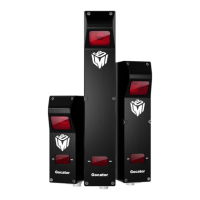Gocator 2300 & 2880 Series
Gocator Web Interface • Scan Setup and Alignment • 89
The Z sub-sampling setting is used to decrease the profile's Z resolution to increase speed. The Z setting
works by reducing the number of image rows used for laser profiling.
Sub-sampling values are expressed as fractions in the Web interface. For example, an X sub-sampling
value of 1/2 indicates that every second camera column will be used for laser profiling.
The CPU Load bar at the top of the interface displays how much the CPU is being used.
Both the X and the Z sub-sampling settings must be decreased to increase speed.
To configure X or Z sub-sampling:
1. Go to the Scan page.
2. Expand the Sensor panel by clicking on the panel header or the button.
3. Click the button corresponding to the sensor you want to configure.
The button is labeled Top, Bottom, Top-Left, or Top-Right, depending on the system.
X and Z sub-sampling can be configured separately for each sensor.
4. Click on the Spacing tab.
5. Select an X or Z sub-sampling value.
6. Save the job in the Toolbar by clicking the Save button .
7. Check that laser profiling is satisfactory.
Spacing Interval
Spacing interval is the spacing between data points in resampled data. (In Profile mode, resampled data
is only produced if the Uniform Spacing option in the Scan Mode panel is checked.) A larger interval
creates profiles with lower X resolution, reduces CPU usage, and potentially increases the maximum
frame rate. A larger interval also reduces the data output rate. For more information on resampled data,
see Uniform Spacing (Data Resampling) on page 46.
The Uniform Spacing option must be checked in the Scan Mode panel for the Spacing
Interval option to be displayed.
You can set the spacing interval either to one of three presets or set a custom value.
To configure the spacing interval:
1. Go to the Scan page.
2. Choose Profile or Surface mode in the Scan Mode panel.
If one of these modes is not selected, you will not be able to configure the spacing interval.
3. Expand the Sensor panel by clicking on the panel header or the button.
4. Click the button corresponding to the sensor you want to configure.
The button is labeled Top, Bottom, Top-Left, or Top-Right, depending on the system.
